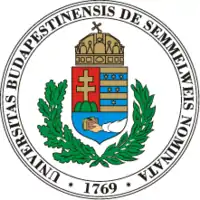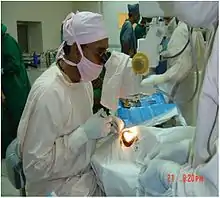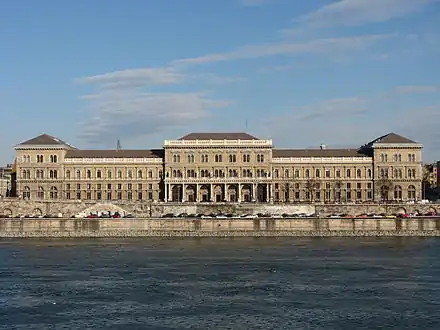Semmelweis University
Semmelweis University (Hungarian: Semmelweis Egyetem) is a research-led medical school in Budapest, Hungary, founded in 1769. Its 250 years of tradition and unique focus on health care made it one of the leading universities of medicine and health sciences in Hungary and the Central European region.[1] With its six faculties and doctoral school it covers all aspects of medical and health sciences ranging from pathology through genetics, paediatrics, pharmacy, dentistry, dietetics, physiotherapy, nursing, health policy and management to conductor training.
 Semmelweis University Coat Of Arms | |
| Latin: Universitas Budapestinensis de Semmelweis nominata | |
| Motto | Servamus Vitam Atque Servimus |
|---|---|
Motto in English | Protecting And Serving Life |
| Type | Public |
| Established | 1769 |
| Rector | Béla Merkely |
| Students | about 10,300 (in 2014) |
| Location | , |
| Campus | Urban |
| Affiliations | NCFMEA, EUA, WHO |
| Website | semmelweis.hu |
In addition to teaching, Semmelweis University is the largest provider of health care services in Hungary. Most of the departments cater for the most serious cases and patients requiring complex treatment, thus making the university a national health care provider.[1]
Research, development, and innovation comprise an important part of the university's three-fold mission. The target of research at the university are early diagnostics and therapy, disease prevention and active ageing. Currently, there are 300 research groups at the university including 31 international and 94 Hungarian research grants.[1]
Buildings and sites
The university does not have a campus. Instead, its faculties, departments, hospitals, clinics, libraries, sport and accommodation facilities are scattered throughout Budapest, the capital city of Hungary. There are some facilities that are clustered, and most of its clinical departments belong to one of the three clinical blocks.

The university's Theoretical Building at Nagyvárad tér is the tallest high rise in Hungary and the iconic building of Semmelweis University. It houses several research institutions, a student centre, the office of the Students’ Union, auditoriums, conference halls and the country's largest stained glass installations.[2]
The previously fragmented Faculty of Health Sciences was united in 2003 in the newly renovated Art Nouveau building of a former sanatorium. The faculty's building houses state-of-the art clinical skills laboratories and contains various social spaces for students to use, such as the atrium, complete with comfortable couches and a lush garden hidden among the walls of the former sanatorium.[3]
The Dental Clinical and Training Centre was completed in 2007, accommodating well-equipped clinics and institutions.
The Basic Medical Science Centre was built in 2008 to cater for an ever-rising number of students with spaces and equipment fulfilling the technological requirements of the 21st century. Over a third of its area is dedicated to scientific research, and it sports large auditoriums and smaller lecture halls. The building is also home to several research groups awarded with renowned scientific grants and participating in international collaborations.[4]
The Inner Clinical Block is located close to the metro stop “Corvin” of metro line 3 and contains the main building and some of the university's hospitals. The main building houses the Rector's Office, the Deans’ Offices and other organisational and administrative units, as well as Semmelweis Salon, a venue for scientific symposia.
Organisation
As a state university, Semmelweis University functions under the auspices of the Ministry of Human Capacities comprising six faculties and a school of doctoral studies. The main governing body of Semmelweis University is the Senate, with the rector as its president. It is endowed with the authority to make decisions and recommendations, to form opinions, and to supervise. The Senate determines the course of the university's educational and research activities and sees to their realisation, with due regard to the Founding Charter.
Leadership
The leadership of Semmelweis University consists of the Rector, responsible for educational and scientific affairs and the Chancellor, overseeing the financial matters of the university. The Rector is aided by five Vice-Rectors: the Vice-Rector for General Affairs, the Vice-Rector for Educational Affairs, the Vice-Rector for Science and Innovation, the Vice-Rector for Clinical Affairs and the Vice-Rector for Strategy and Development.
- Rector: Dr. Béla Merkely
- Chancellor: Dr. Lívia Pavlik
- Vice-Rector for General Affairs: Dr. Ferenc Bánhidy
- Vice-Rector for Educational Affairs: Dr. Péter Hermann
- Vice-Rector for Science and Innovation: Dr. Péter Ferdinandy
- Vice-Rector for Clinical Affairs: Dr. Attila Szabó
- Vice-Rector for Strategy and Development: Dr. Éva Szabó Feketéné
- Vice-Rector for International Studies: Dr. Alán Alpár[5]
Faculties
Semmelweis University is a specialised university offering undergraduate and graduate courses only in the field of health sciences. The university has around 10,000 students from 60 nations over five continents. Foreign students account for about 18% of the total community.[6] The largest and oldest faculty of the university is the Faculty of Medicine with 4,500 students accounting for 40% of the total number of students.[7]
- András Pető Faculty
- Faculty of Dentistry
- Faculty of Health and Public Services
- Faculty of Health Sciences
- Faculty of Medicine
- Faculty of Pharmaceutical Sciences
- School of Ph.D. Studies
Academics
Semmelweis University offers a wide range of medical education at six faculties. Its numerous clinical departments and clinical skill laboratories provide practical education in small groups for students attending any courses at any of the faculties. Nearly 11,000 students are taking courses in One-tier Master Programmes and at Bachelor, Master's and Postgradual levels and 1,500 of them are granted a diploma each year.
Integrated Master Programs (One-tier Master Programs)
Medicine, Dentistry and Pharmacy run as one-tier master programs (integrated master) with a degree awarded at the end of five years of study in Dentistry and Pharmacy and six years in Medicine. These courses are one-tier degree courses, without intermediate exit, and are in alternative to the two-tier degree course scheme.[8]
Courses in Medicine, Dentistry and Pharmacy are available in Hungarian, English and German.
Bachelor’s Programs
Bachelor's Programs of Semmelweis University are offered at the Faculty of Health Sciences. The length of the programs is 8 semesters (4 years) with a total of 240 credit points.
The following Bachelor's programs are available in English:
- Physiotherapy
- Nursing
- Midwifery
- Dietetics
- Medical Diagnostic Analysis – Optometry
- Public Health Supervisor [9]
The Physiotherapy program is available in Italian within the framework of the university's off-campus program run in Lugano, Switzerland.
Master's Programs
Master's Programs are offered at the Faculty of Health and Public Services and the Faculty of Health Sciences. The length of the programs is 3 semesters (1.5 years) with a total of 90 credit points.
The following Master's Programs are available in English at the Faculty of Health Sciences:
- Physiotherapy
- Nursing[10]
Postgraduate education
Semmelweis University's School of Ph.D. Studies has 7 Doctoral Schools: Basic Medicine, Clinical Medicine, Pharmaceutical Sciences, Mental Health Sciences, Neurosciences, Molecular Medicine and Pathological Sciences. Each school comprises 2 to 17 study programs that add up to over 40 programs all together. The Doctoral School of Semmelweis University integrates the research groups and programs of all Faculties entitled to issue Ph.D. degrees. The Doctoral School of Semmelweis University is currently one of its most progressive divisions with around a hundred students obtaining their Ph.D. diplomas every year. The degrees are recognized by the European Union and are accepted in many other countries around the world.[11]
Research

Research, development, and innovation at Semmelweis University take place in the areas of living natural sciences, and social sciences. Within these, life science R&D activities are the most prominent. The scientific areas connected to the Ph.D. programme are theoretical, clinical, molecular and multidisciplinary medicine, pharmaceutical sciences, mental health sciences, and pathological sciences. Physical science research is limited to certain segments of theoretical medicine and social science research is employed in the areas of mental health.
R&D and training synergies are realised at Semmelweis University in several ways. R&D results quickly make their way into clinical and health sciences as well as into the university's educational activities and the curriculum. The synergies also manifest themselves in the various specialised networks operating at the university (e.g. nanotechnology, bioimaging, genomics, biobank), as well as in the research university modules (diagnostics, technology, therapy, prevention) and the dynamic collaborations which have been developing within these areas.
Semmelweis University's large collection of academic journals comprise printed material, online resources (databases, full text e-journals, e-books, etc.) that may be accessed both on-campus and off-campus. The Central Library provides access to more than 5,000 full text e-journals and numerous specialised databases through its website.[12]
Numerous internationally recognised patents are connected to Semmelweis University, such as the iKnife, a surgical device that is able to tell healthy and cancerous tissues apart in just a few seconds after the first cut,[13] or the virtual 3D microscope, a device equipped with a microscope slide scanner able to scan 300 slides in one run and a 3D viewer that creates a spatial reconstruction of the serial specimen.[14]
International relations
Semmelweis University has an extended network of international relations spanning across five continents, including around a hundred universities within the Erasmus+ network and other 40 universities in joint cooperation based on bilateral agreements.
Off-campus programs
Over a decade ago, Semmelweis University was among the first European higher education institutions to introduce cross-border programs. These programs allow foreign students to follow the Semmelweis curriculum while undertaking their studies at the partner institution abroad.
Venues of Semmelweis University's off-campus programs:
- Asklepios Campus Hamburg: This education model provides Semmelweis students with the opportunity to continue their studies in Hamburg after having successfully completed two years of theoretical training in Budapest. The program at the Asklepios Campus entirely follows the Semmelweis curriculum and it provides the students with a Semmelweis diploma at the end of their studies. The Faculty of Medicine Asklepios Campus Hamburg is a binational faculty which operates under the supervision of the university's Faculty of Medicine.
- Lugano Libera Università degli Studi: The L.U.de.S. Physiotherapy BSc program is completely identical with the one offered at the Faculty of Health Sciences. Accordingly, the program consists of 4 years and is based on both theoretical and practice-oriented courses. The language of instruction is English and Italian in this program. The program provides a diploma which is accepted and valid in the entire European Union
- Bratislava – Health Management Academy: Health Manager MSc in Slovakian.[15]
International joint projects
Semmelweis University runs research and student exchange programmes in collaboration with several universities around the world based on bilateral agreements. The programmes offer scholarships to students with outstanding academic results and staff to study or do research at the partner institutions. The programmes are based on reciprocity and the length of exchange programmes may vary from one week to 3 months.[16] Semmelweis University's partner institutions:
- State University of New York Buffalo School of Medicine
- University of California Davis School of Medicine
- Rutgers University
- Medical University of Innsbruck
- Saitama Medical University
- University of Freiburg
- Heidelberg University
- University of Ulm
- University of Padua
- University of Trieste
- Comenius University Jessenius Faculty of Medicine in Martin
International mobility
The Erasmus+ mobility programme provides Semmelweis University's students and staff with the opportunity to undertake study, teaching or training programmes both within and outside Europe. The university receives about 150 incoming students each year and around 120 students from Semmelweis University's six faculties participate in the exchange programme.
EURAXESS
EURAXESS is a unique web-based service which provides researchers with the opportunity to work abroad and also assists companies and institutions who would like to employ international researchers. Semmelweis University's Erasmus Office works together with the EURAXESS Hungary Team to assist Hungarian and foreign researchers to work abroad or study at Semmelweis University.
Student life
Semmelweis University has about 11,000 students studying at the six faculties and over 30 percent come from abroad. The largest events for students are the Academic Year Opening Ceremony and the Graduation Ceremony, bringing together hundreds of Hungarian and international students. The university's sites and buildings are located in the Hungarian capital city, most of them in the historical city centre, thus providing the students with a colourful and vibrant cultural life. Accommodation for students is available at several dormitories. Community areas are located in most of the main buildings offering recreational and networking opportunities.
Traditional events
Semmelweis University has various student groups, the largest one of them is ISSA (International Semmelweis Students Association). Together with the Students’ Union they organize a variety of events ranging from the Freshers’ Camp, Freshers’ Ball, Semmelweis Carnival and the Semmelweis Spring Festival.
Semmelweis Carnival aims to bring together Hungarian and international students studying in the English and German programmes. The Multicultural Food Festival is part of the carnival with international students preparing their traditional dishes.[17]
Scientific events
Semmelweis University organises a variety of large and small scientific events each year. Researcher's Salon, held on a monthly basis, has provided an opportunity for Semmelweis University's most eminent scholars to introduce themselves since 2012. The Salon allows scholars and talented young researchers receiving awards, distinctions, or leadership appointments to introduce themselves in an intellectual environment.
The university organises numerous international conferences and congresses, the most significant of which is the annual Semmelweis Symposium.
Semmelweis University has been participating in the Researchers’ Night for the past several years. The initiative seeks to present research results that, no matter how significant, have not reached the general population, or have been presented in a way not easily understood. The event also allows young people to discover the beauty of the medical field, and provides those considering a career in health care with a thorough introduction to the institution.
Students represent the university at several national and international scientific events. Those involved in scientific work have the opportunity to showcase their knowledge at the annual Students’ Scientific Association Conference, while many of the university's exceptional students participate in the National Students’ Scientific Association Conference, organised at a different Hungarian higher educational institution each year.
Semmelweis Career Day is the university's independent career fair attended by not only organisations engaged in scientific work, but by scientific research companies working in the health market, as well.[17]
Sporting events
A Pool Party is organised every September where, in addition to swimming, participants can also enjoy a variety of social games. Other popular events are the Football Tournament and the NET Running, both of which are held in the autumn and spring of each year. The most significant winter event is the Semmelweis Ice Carnival, during which participants can skate for free on the largest open-air skating rink of Budapest.[17]
International acclaim
Semmelweis University ranks among the top 200 universities in the world in pharmacy education, according to the latest university subject rankings published by the QS World University Rankings. The university also placed the best in Hungary in the broad subject area of life sciences and medicine.
In the 2019 Times Higher Education World University Rankings Semmelweis University is placed between 400 and 500.[18]
Notable people
- Ignác Semmelweis (1818–1865), popularly known as “the saviour of mothers”. He began his career in Vienna; it was there that he discovered the cause of puerperal fever. He left Vienna for the Medical Faculty of the Imperial and Royal University of Pest (now Semmelweis University), where he served as professor and director of the Department of Obstetrics and Gynaecology from 1855 to 1865.
- Albert Szent-Györgyi (1893–1986) is the only Hungarian Nobel laureate who received the distinction for research conducted in Hungary. He earned his diploma at the medical faculty in Budapest (now Semmelweis University). He successfully isolated vitamin C and discovered the components and reactions of the citric acid cycle at the University of Szeged. Szent-Györgyi returned to the University of Budapest's Faculty of Medicine after the war, but emigrated to the US in 1947.
- László Szollás (1907–1980), world champion and Olympic medalist pair skater.
- Judith Forrai (born 1949), Hungarian historian of science, medical historian, dentist, professor, doctor of the Hungarian Academy of Sciences, and journal editor-in-chief.
- Zoltán Kovács (born 1962), vice-president of the Hungarian Ice Hockey Federation and Paul Loicq Award recipient, graduated with Master of Physical Education degree in 1992 at the Faculty of Physical Education and Sport Sciences.[19]
Gallery
 Building of the Anatomical Institute, inaugurated in 1878
Building of the Anatomical Institute, inaugurated in 1878 1st Department of Internal Medicine, Józsefvárosi Clinical Complex
1st Department of Internal Medicine, Józsefvárosi Clinical Complex Kútvölgyi Clinical Unit
Kútvölgyi Clinical Unit Semmelweis University Tower
Semmelweis University Tower Department of Paediatrics
Department of Paediatrics Basic Medical Science Centre
Basic Medical Science Centre%252C_2017_Palotanegyed.jpg.webp) Facade of the Faculty of Health Sciences
Facade of the Faculty of Health Sciences
See also
References
- "The University". semmelweis.hu. Retrieved 2019-03-20.
- Christopher, Adam (4 October 2017). "Budapest skyscraper sparks controversy". Hungarian Free Press. Retrieved 21 March 2019.
- Prusinszki, István. "Iszappal is gyógyítottak a Vas utcában". Népszabadság Online. Retrieved 21 March 2019.
- "Történet". semmelweis.hu (in Hungarian). Retrieved 2019-03-21.
- "Leaders of the University". semmelweis.hu. Retrieved 2019-03-21.
- "The University | Semmelweis University". Semmelweis.hu. Retrieved 2016-08-22.
- "Facts and Figures". semmelweis.hu. Retrieved 2019-03-21.
- Wilson, Macha (11 December 2018). "Incompatible With Bologna? The Two-Cycle Degree Structure in Medical Education in the EHEA". World Education News + Reviews. Retrieved 21 March 2019.
- "Study finder". Study in Hungary. Retrieved 21 March 2019.
- Foundation, Tempus Public. "Study In Hungary – Study finder". studyinhungary.hu. Retrieved 2019-03-21.
- Tímár, József. "About". Károly Rácz School of Ph.D. Studies. Retrieved 21 March 2019.
- "Research and Development". semmelweis.hu. Retrieved 2019-03-23.
- Phelps DL, Balog J, Gildea LF, Bodai ZS, Savage A, El-Bahrawy MA, Speller A, Rosini F, Kudo H, McKenzie J, Brown R, Takáts Z, Ghaem-Maghami S (19 April 2018). "The surgical intelligent knife distinguishes normal, borderline and malignant gynaecological tissues using rapid evaporative ionisation mass spectrometry (REIMS)". British Journal of Cancer. 118 (10): 1349–1358. doi:10.1038/s41416-018-0048-3. PMC 5959892. PMID 29670294.
- Krenács T, Zsakovics I, Micsik T, Fonyad L, Varga, V, Ficsor L, Kiszler G, Molnár B (January 2010). "Digital microscopy: The upcoming revolution in histopathology teaching, diagnostics, research and quality assurance". Microscopy: Science, Technology, Applications and Education: 965–977.
- "Off-campus Programs". semmelweis.hu. Retrieved 2019-03-23.
- "Kiemelt csereegyezményes kapcsolataink". semmelweis.hu (in Hungarian). Retrieved 2019-03-23.
- "Events". semmelweis.hu. Retrieved 2019-03-23.
- "World University Rankings". Times Higher Education (THE). 2018-09-26. Retrieved 2019-03-23.
- Podnieks, Andrew (February 4, 2020). "Legends join IIHF Hall of Fame". International Ice Hockey Federation. Retrieved February 4, 2020.
External links
| Wikimedia Commons has media related to Semmelweis University. |
- Semmelweis University's official Hungarian website
- Semmelweis University's official English website
- Semmelweis University English language program
- Spanish Representative of Semmelweis University
- Asklepios Campus Hamburg website
- Lugano Libera Università degli Studi
- EURAXESS
- European Mobility Office
- International Semmelweis Student Association (ISSA)

